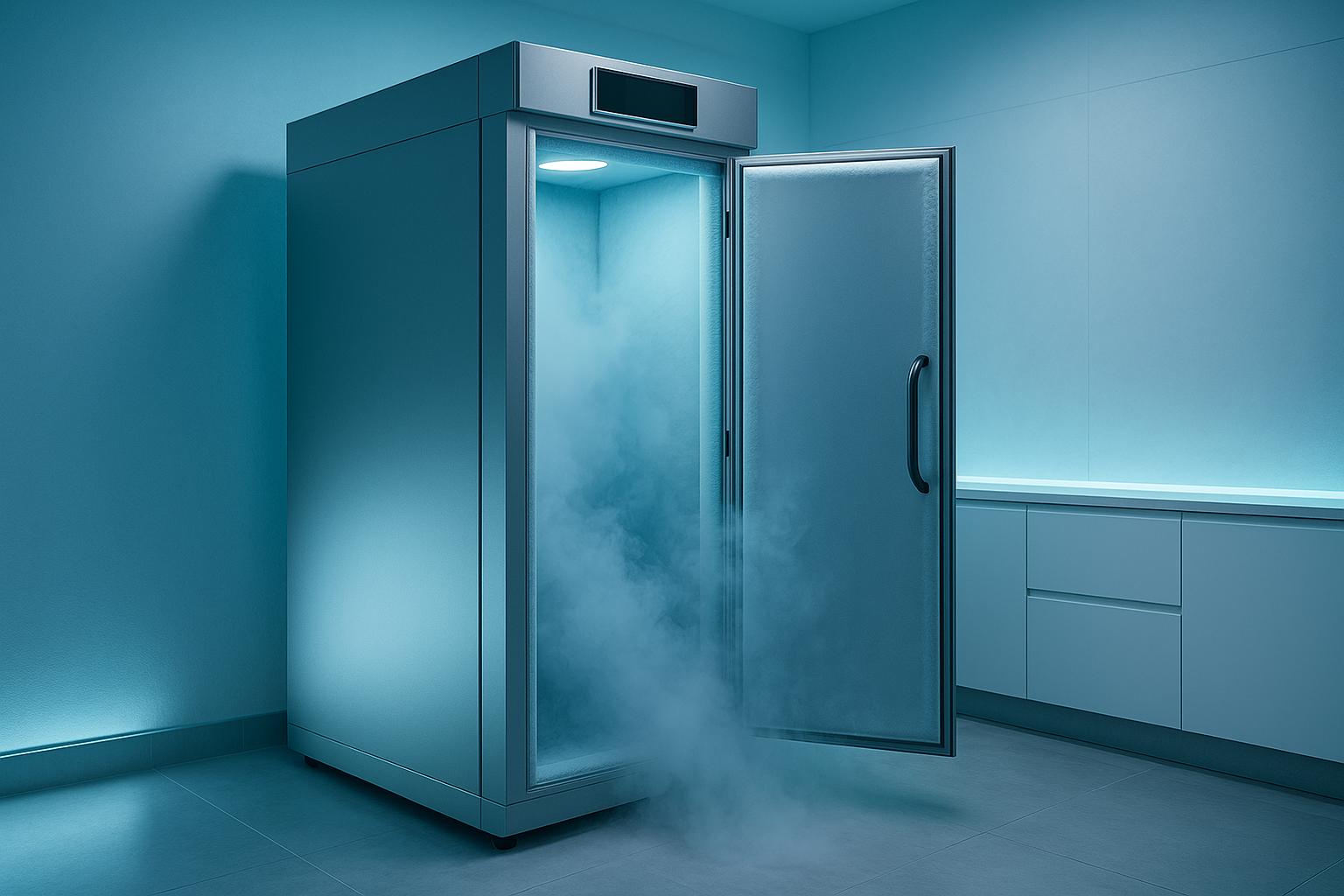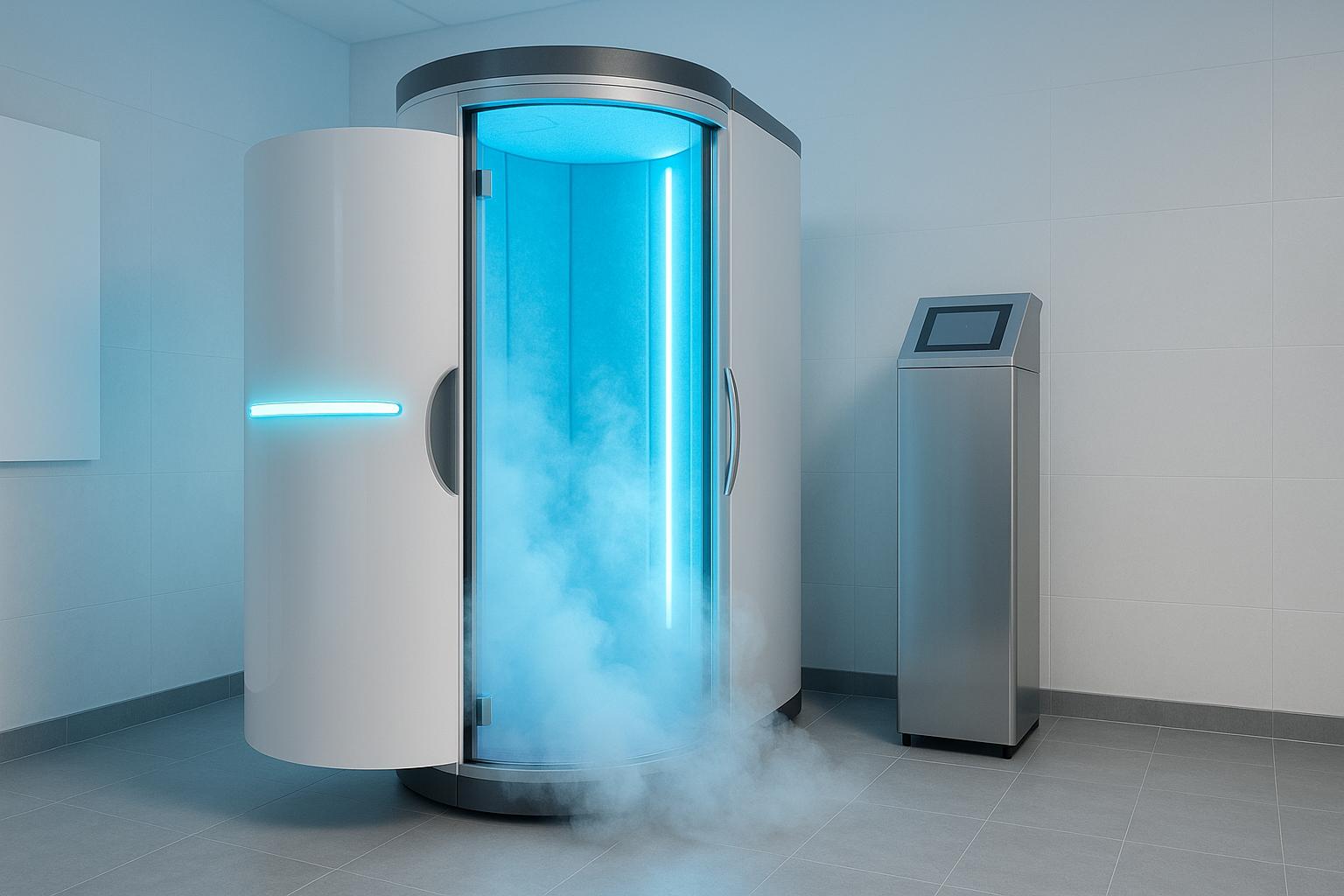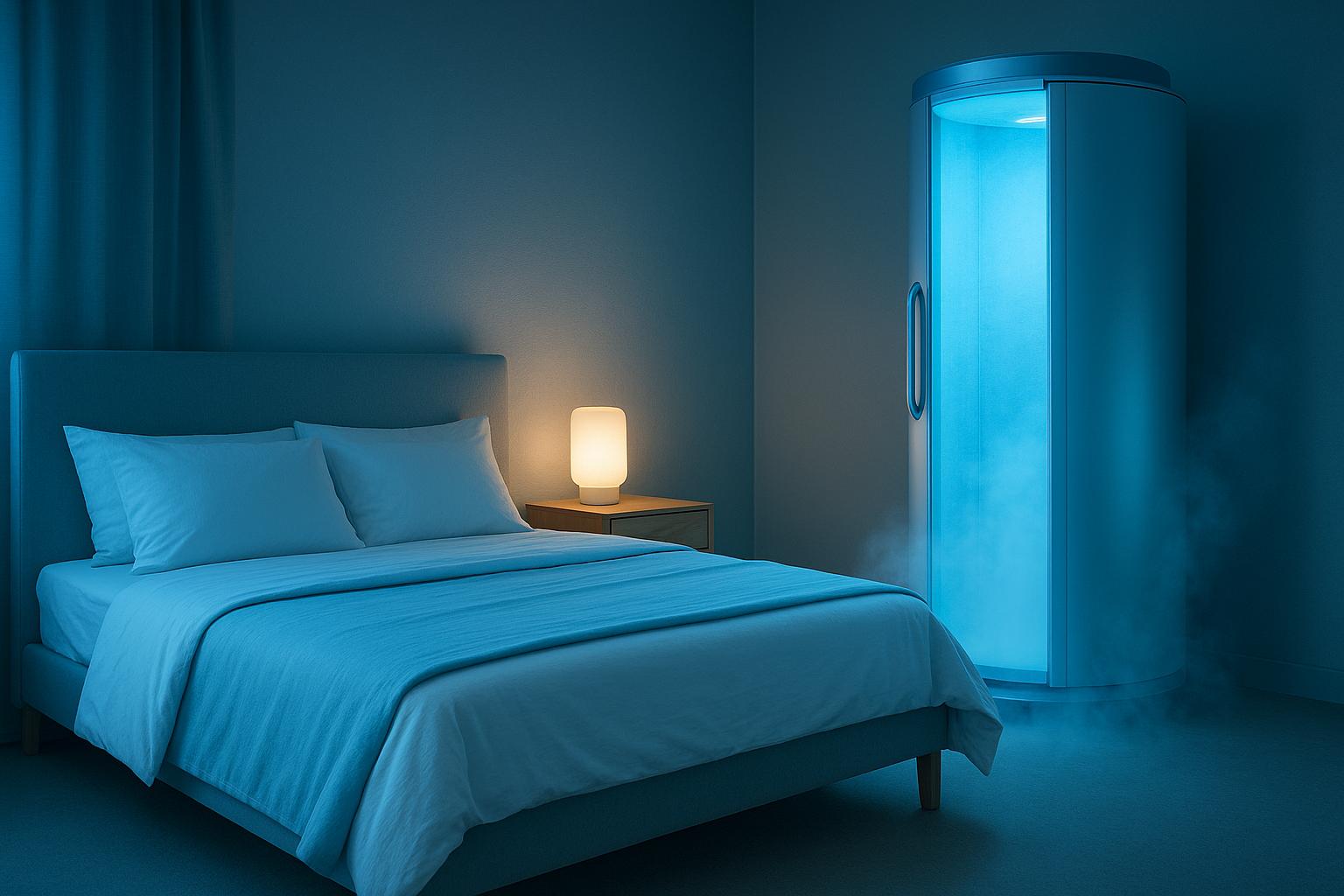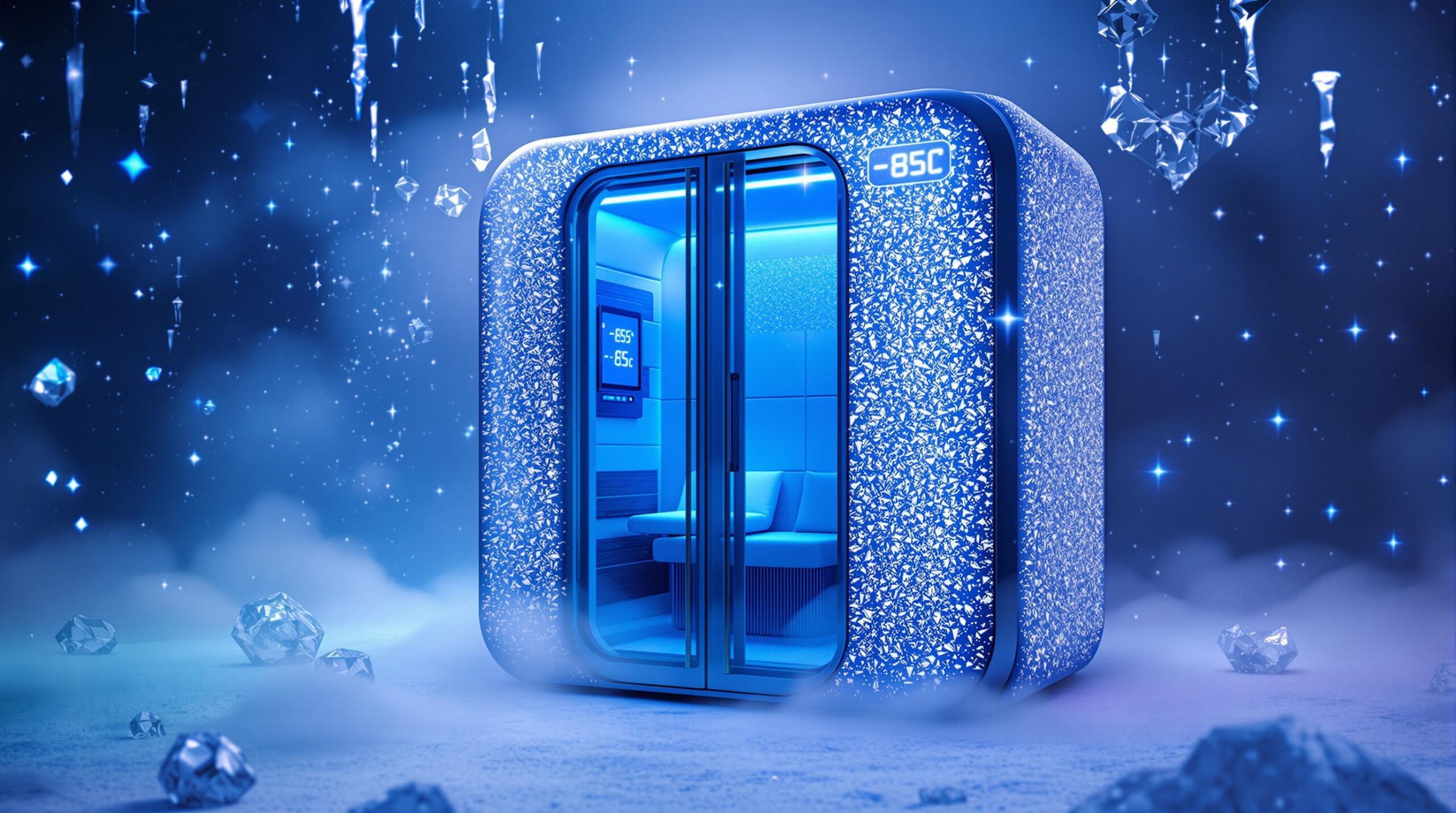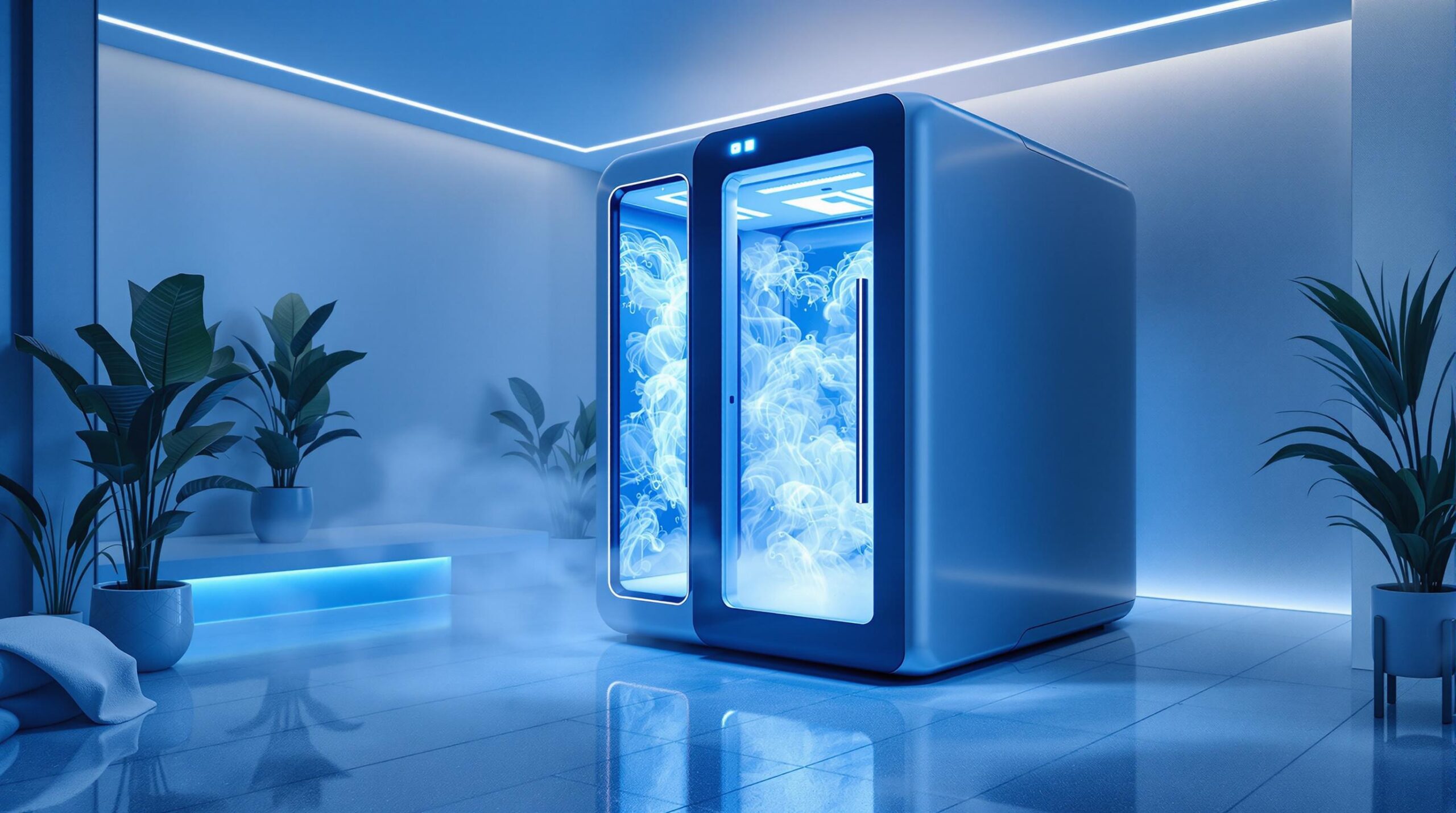Cryotherapy, a treatment using extremely cold temperatures, is gaining attention for managing chronic pain conditions like arthritis, fibromyalgia, and back pain. It works by reducing nerve activity and inflammation, offering potential pain relief and improved mobility. Research shows benefits such as an 89% increase in pain threshold and reduced inflammatory markers.
Key Points:
- How It Works: Lowers nerve conduction and inflammation.
- Conditions Treated: Rheumatic disorders, osteoarthritis, fibromyalgia, and more.
- Treatment Process: Sessions last 3–5 minutes at temperatures as low as –85°C.
- Benefits: Pain relief, reduced fatigue, and improved mobility.
- Safety: Not suitable for certain medical conditions like cardiovascular issues.
Cryotherapy shows promise, but consult your GP to ensure it’s right for you.
The Science of Cold Therapy
How Cold Affects Pain Signals
Cold therapy has a direct impact on how pain signals are processed. Studies show that cryotherapy slows down nerve conduction velocity (NCV), especially when applied consistently, such as in The Cryo Hub’s advanced electric cryochamber.
When skin temperature drops to 10°C, research has observed a 33% reduction in nerve conduction velocity [3]. This happens because cold temperatures influence calcium and sodium ion exchange in nerve cells, delaying the creation of action potentials [3].
Here are some key findings:
- An 89% increase in pain threshold at the cooled site
- A 76% increase in pain tolerance at the cooled site
- For every 1°C drop in skin temperature, sensory nerve conduction slows by 0.4 metres per second [3]
These changes in nerve activity pave the way for additional benefits, including hormonal adjustments that further help with pain relief.
Hormonal Shifts for Pain Relief
Cryotherapy doesn’t just target nerve signals; it also triggers hormonal changes that contribute to easing pain. Immersing the body in The Cryo Hub’s electric cryochamber has been shown to influence stress-related hormones.
Research on athletes highlights these two important effects during cryotherapy sessions [4]:
- Lower Stress Hormones: Levels of cortisol and dehydroepiandrosterone (DHEA), both linked to stress and pain, are reduced.
- Higher Performance Hormones: Testosterone levels rise, aiding recovery and pain management [4].
"WBC affects the hormonal asset, decreasing hormones typically associated with psychophysical stress, such as cortisol, and increasing testosterone, a typical anabolic hormone." [4]
Cryotherapy also helps regulate inflammation. It reduces pro-inflammatory cytokines like TNF-α and increases anti-inflammatory ones like IL-10 [2]. This dual effect creates a strong anti-inflammatory response, which further supports pain relief.
As Carol Garcia and her team explain:
"The mechanism behind this pain reduction is thought to occur through the reduction of inflammation and edema, oxidative stress, and nerve conduction velocity in pain fibres." [2]
Research on Cryotherapy for Pain Relief
Clinical Study Results
A review of 25 studies, including 22 randomised controlled trials, highlights its effectiveness in managing rheumatic and degenerative pain [2].
One 2017 study focused on primary knee osteoarthritis and found that a two-week routine of 20-minute cold pack sessions, performed twice daily, significantly reduced pain at rest, during movement, and while sleeping. These effects lasted for at least two weeks [2].
For rheumatic conditions, whole-body cryotherapy (WBC) the electric cryochamber used in our treatments ensures full-body immersion, including the head, with precise temperature control to maximise therapeutic results.
In gouty arthritis cases, local ice pack treatments reduced pain by 7.75 cm on the Visual Analogue Scale (VAS) [2]. Meanwhile, combining WBC with rehabilitation produced better results than rehabilitation alone [2].
Additional studies provide further insights:
| Condition Type | Temperature Used | Observed Outcome |
|---|---|---|
| Rheumatic Diseases | -85°C | Significant reduction in pain on the VAS scale |
| Degenerative Diseases | Around -5°C | Improved mobility and reduced pain |
| Fibromyalgia | -85°C (multiple sessions) | Lower fatigue severity scores [5] |
Gaps in Current Studies
Despite these promising findings, there are still notable gaps in research. A key issue is the lack of standardisation across studies, which complicates comprehensive meta-analyses [6].
"Local and non-local cryotherapy can be low-risk and easy treatment options to add in the management of chronic pain in carefully selected patients" [2].
More research is needed to determine the long-term effects of regular cryotherapy, establish precise treatment protocols for various conditions, and compare the effectiveness of whole-body versus localised cryotherapy. Additionally, standardised methods for measuring pain reduction are crucial.
The Cryo Hub is actively working to address these challenges by utilising consistent treatment protocols and advanced electric cryochamber technology. Many existing studies combine cryotherapy with other treatments or lack proper control groups, making it difficult to isolate cryotherapy’s specific benefits [6][1].
Treatment Options for Different Pain Types
Common Pain Conditions Treated
Whole-body cryotherapy has been shown to help manage chronic pain effectively, backed by research and clinical studies. At The Cryo Hub, our electric cryochamber operates at -85°C, providing full-body exposure with consistent temperature levels. Our WBC chamber ensures full body (including the head) exposure to the cold which results in a safe, but highly effective Cryotherapy experience.
Rheumatic Conditions
Studies show that cryotherapy can ease pain and reduce inflammation in conditions like rheumatoid arthritis and similar disorders [2].
Degenerative Conditions
For osteoarthritis, many patients experience less joint pain and improved mobility. Research supports cryotherapy’s benefits across a range of cold exposure treatments [2].
| Condition Type | Treatment Duration | Expected Benefits |
|---|---|---|
| Rheumatic Disorders | 3–5 minutes | Pain relief, reduced inflammation |
| Osteoarthritis | 3–5 minutes | Better mobility, less joint discomfort |
| Fibromyalgia | 3–5 minutes | Lower pain sensitivity, reduced fatigue |
| Chronic Back Pain | 3–5 minutes | Eased muscle tension, improved flexibility |
These treatment durations and benefits are carefully tailored to ensure optimal results during each session.
The Cryo Hub Treatment Process
Our treatment process is designed to deliver consistent results, focusing on individual needs and conditions.
Before starting therapy, we conduct an assessment to identify the specific pain condition and check for any contraindications, such as Raynaud’s disease or peripheral vascular issues [2]. Based on this evaluation, our trained physiotherapists create a customised treatment plan using the full-body cryochamber. The chamber ensures complete exposure, including the head, for maximum therapeutic effect.
Each session is closely monitored by our physiotherapists, who adjust the settings as needed to suit individual responses. The usual treatment schedule includes:
- Initial phase: 2–3 sessions per week
- Maintenance phase: Weekly or fortnightly sessions
Patients often report noticeable improvements in their symptoms and overall quality of life, thanks to The Cryo Hub’s expertise in whole-body cryotherapy.
sbb-itb-32603e3
Safety Guidelines and Risks
Medical Restrictions
Certain medical conditions can make cryotherapy unsuitable or potentially harmful. These include:
- Cardiovascular Issues: Unstable angina, peripheral vascular disease, and cardiac failure.
- Neurological and Circulatory Conditions: Raynaud’s syndrome, cryoglobulinaemia, deep vein thrombosis (DVT), and severe anaemia.
- Other Conditions: Pregnancy, acute respiratory problems, hypothyroidism, seizure disorders, and open wounds or healing complications.
At The Cryo Hub, we take these risks seriously and have strict protocols to ensure every session is as safe as possible.
Safety Measures at The Cryo Hub
The Cryo Hub operates an advanced electric cryochamber, keeping the temperature precisely controlled at -110°C. This eliminates the risks associated with nitrogen-based systems.
Pre-Treatment Safety Protocol
Before every session, we follow these steps:
- A review of the client’s medical history.
- Safety Briefing
- Providing the necessary protective gear, including a headband, face mask, thermal gloves, long socks, and thermal slippers.
During the Session
Our trained operators monitor clients closely for any adverse reactions. Sessions are carefully limited to 3–5 minutes, and the chamber ensures even temperature distribution for optimal impacts and safety.
Post-Treatment Care
We perform a post-session evaluation to ensure the client’s wellbeing. Safety measures also include skin-temperature monitoring, and emergency stop functions.
In 2019, regulated centres in France safely conducted over one million cryotherapy sessions [7]. At The Cryo Hub, we uphold these high standards, ensuring both effective treatment and client safety.
Professional Views and Patient Results
Medical Expert Analysis
Doctors and researchers have highlighted whole-body cryotherapy as an effective option for managing chronic pain, especially in conditions like rheumatic and degenerative disorders [2]. For example, studies show that patients with ankylosing spondylitis who underwent whole-body cryotherapy alongside rehabilitation reported noticeably lower pain levels compared to those who only received rehabilitation [2].
At The Cryo Hub, our advanced electric cryochamber is designed for full-body exposure, maintaining a consistent temperature down to -85°C. Unlike gas-based systems, this setup avoids temperature inconsistencies and potential risks, ensuring a safer and more reliable experience. These findings align with the clear improvements seen in our patients.
The Cryo Hub Patient Outcomes
Data from The Cryo Hub’s treatment programmes show clear benefits in pain relief. For instance, patients with fibromyalgia have reported reduced pain levels on the Visual Analogue Scale (VAS) [2].
Here’s a summary of the benefits observed for different conditions:
| Pain Condition | Benefits | Treatment Protocol |
|---|---|---|
| Rheumatic Disorders | Less inflammation and reduced pain | Bi-weekly 3–5 minute sessions |
| Osteoarthritis | Better mobility and less pain | Regular sessions with physiotherapist input |
| Fibromyalgia | Lower pain scores on the VAS scale | Weekly controlled exposure in the cryochamber |
Progress is tracked, allowing for tailored adjustments to their treatment plan. The combination of expert advice and the precise temperature control of our electric cryochamber has led to consistently positive results in managing pain for a variety of conditions.
Benefits of Cryotherapy | Patient Education
Making an Informed Decision
Building on the research and patient outcomes discussed earlier, here are some key points to help you make a well-rounded decision.
Main Points to Consider
When evaluating cryotherapy for chronic pain, it’s important to weigh the evidence. Studies indicate that both local and whole-body cryotherapy can help manage chronic pain, particularly in cases linked to rheumatic and degenerative conditions [2].
| Pain Type | Required Temperature | Reported Benefits |
|---|---|---|
| Rheumatic Conditions | −85°C | Reduction in inflammation |
| Degenerative Diseases | −5°C to −85°C | Relief from structural pain |
| Gouty Arthritis | Local cooling and WBC | Pain reduction (measured on VAS scale) |
These differences in treatment approaches can help set realistic expectations and guide therapy plans. If you have circulatory issues, diabetes, or sensitivity to cold, consult your GP before starting cryotherapy. Consistency and proper medical screening are key to effective results.
Why Choose The Cryo Hub
The Cryo Hub offers an advanced electric cryochamber designed for full-body treatment. Unlike nitrogen-based systems, this chamber ensures a steady and uniform temperature throughout your session.
Key features include:
- Complete Immersion: Delivers consistent, thorough treatment.
- Precise Temperature Control: Maintains an optimal environment at −85°C.
- Professional Oversight: Expert physiotherapists monitor each 3–5-minute session to customise the experience.

